The history of the Spanish transporting gold and silver through Panamá had permeated our trip so far. We wandered the streets of Casco Antiguo, which was established after Captain Morgan sacked Panamá Viejo seeking the gold and silver that the Spanish seized from South America. Indeed, the reason Panamá City wasn’t completely wiped off the map by Captain Morgan was that the Spanish quickly re-established the city in Casco Antiguo to continue the extraction of precious metals from South America. On the Caribbean side, we visited el Fuerte de San Lorenzo, the Spanish fort protecting boats carrying the precious metals down the Chagres River as well as Spanish ships carrying those treasures to Europe.
On Day 5, we filled in some of the gap between these two ends by hiking a portion of a trail that follows el Camino de Cruces. Built in 1530, the Camino de Cruces was a narrow road through the jungle that the Spanish used to transport people, goods, and sometimes valuables first from Panamá Viejo and then from Casco Antiguo overland on mules to the Chagres River, where the heavy but precious cargo was loaded onto boats and floated to el Fuerte de San Lorenzo. Going in reverse, the camino was also the road that Captain Morgan used to reach Panamá Viejo. (In 1587, a barge carrying treasure sank on the Chagres, and thereafter most of the gold and silver from Panamá City was transported on another road, the Camino Real.)
But history was only a small part of the reason that we wanted to hike el Camino de Cruces. It also provides a wonderful opportunity to get deeper into the jungles of Panamá. The Spanish road cuts through the jungle, but sixteenth century builders largely left the surrounding wilderness untouched. Moreover, the road was all-but abandoned in the 1850s when a transcontinental railroad was built in Panamá. Since then, the jungle has reclaimed the tiny track. What remains for hikers is wonderfully wild and potentially a little dangerous for a family from Baltimore, Maryland. As a result, we hired a fantastic guide for our hike, Rainald, who works for Yala Tours.
The plan was for our day to start early at 6:00 am, when Rainald would pick us up at our hotel in Casco Antiguo. However, Julie and I woke in the middle of the night to the sound of something moving in our hotel room. At first, I wasn’t sure if the sound was coming from another part of the hotel, as the sound would come and go. I finally was convinced that something was moving in our hotel room and got up to investigate. After a few minutes of searching, I discovered the source. We had picked up some shells the day before when we swam in the Caribbean. They all looked empty, but one had a hermit crab in it. That poor guy was trying to find the ocean. He didn’t know it, but he’d come a long way from the Caribbean — all the way to the Pacific. Relieved it wasn’t a mouse, I gave Crabtain Morgan some water, put him in the bathroom, and went back to bed.
A couple of hours later, it was time to get up and get ready for the hike. By 6 am, we headed to the lobby, where Rainald was waiting to greet us with a friendly smile. Long ago, the Camino de Cruces started where la Avenida Central left Casco Antiguo. Our hotel that night had been the historic Central Hotel, on la Avenida Central. In a way, we had slept at the start of the Camino de Cruces. We hopped in Rainald’s van and drove to the trailhead, which was about 45 minutes away.

We would be hiking a 6.5 mile stretch of el Camino de Cruces, ending at the ruined remains of Venta de Cruces, a small Spanish town on the banks of the Chagres River. There, a small boat would pick us up to ferry us across the river, where the van would be waiting to take us back to our hotel.

Between our two backpacks, we carried 8 liters of water, as well as some electrolyte packets and pizza. At Rainald’s instruction, we tucked our pants into our socks to keep out any bugs. Before coming to Panamá, we had treated our hiking clothes with permethrin as well. It was 7 am, and we were ready to roll!

From the start, the cobbles from the old road were unmistakable, as you can see in the picture above and the video below.
Here at the start, the trail looked like it was going to be fairly easy going, but the trail quickly shrank as the jungle expanded and intensified.

We soon started seeing massive ceiba trees (ceiba pentandra), which were easy to pick out due to their wide buttress roots.

Ceiba trees can be huge, growing up to 250 feet tall. By comparison, White Oak trees in the US cap out at 100 feet. As we pushed further into the jungle, the trees kept getting bigger, providing a habitat for other plants, including ferns, bromeliads, orchids, and huge vines.
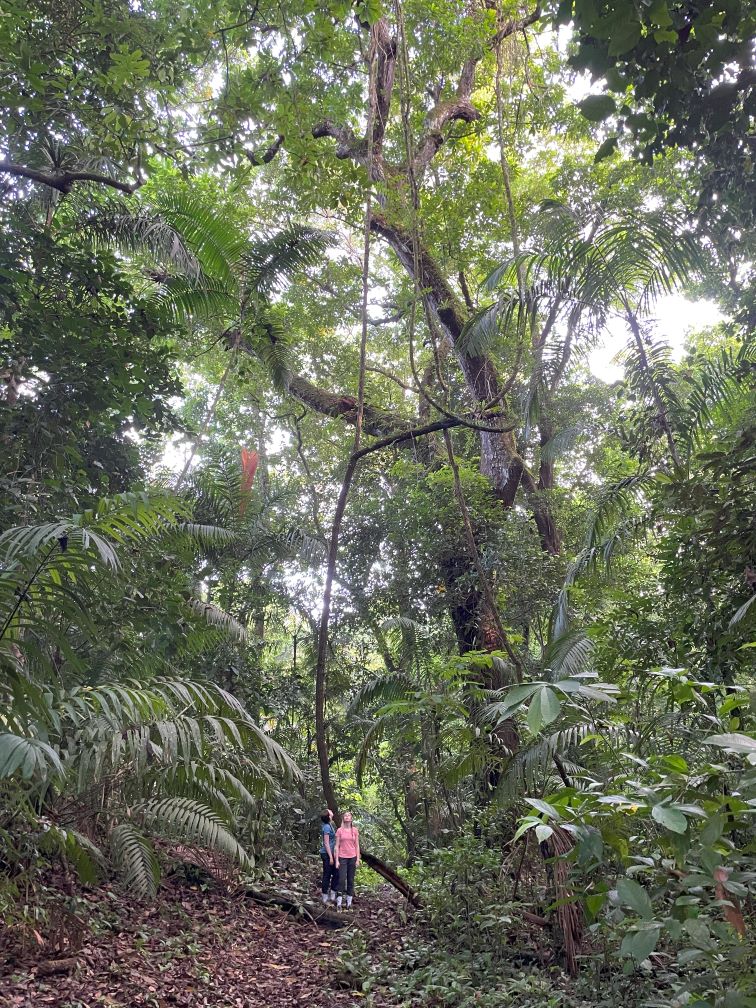
Some of these massive trees also come crashing down from time to time, making the trail harder to follow but also giving us a chance to see some of the vines close up.
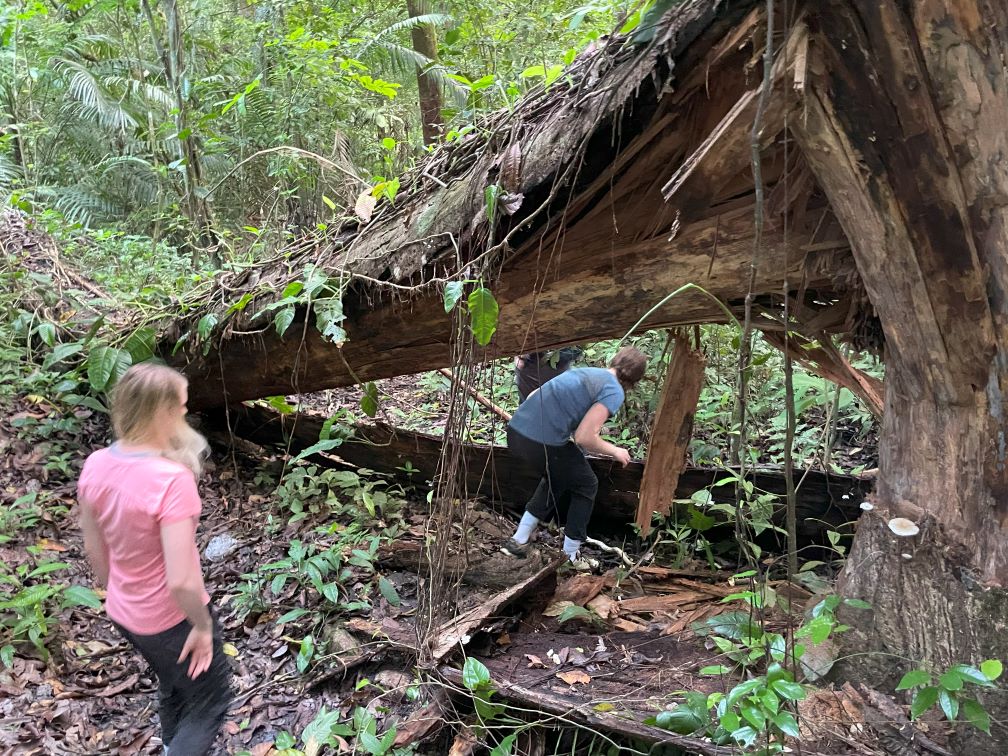
The trees are also home to birds and other animals. As we hiked, we spotted a troop of howler monkeys high in the canopy, walking from tree to tree without ever coming close to the ground.
The monkeys are territorial and use their signature calls to inform other monkeys to steer clear.
We saw other monkeys throughout our hike, including Tamarins and Capuchins. Unfortunately, they were extremely hard to photograph in the high, dense canopy.
Not many tourists hike the Camino de Cruces. Rainald said that he only takes a few groups on the trail each year. It is a longer hike, and the trial is rough in spots.
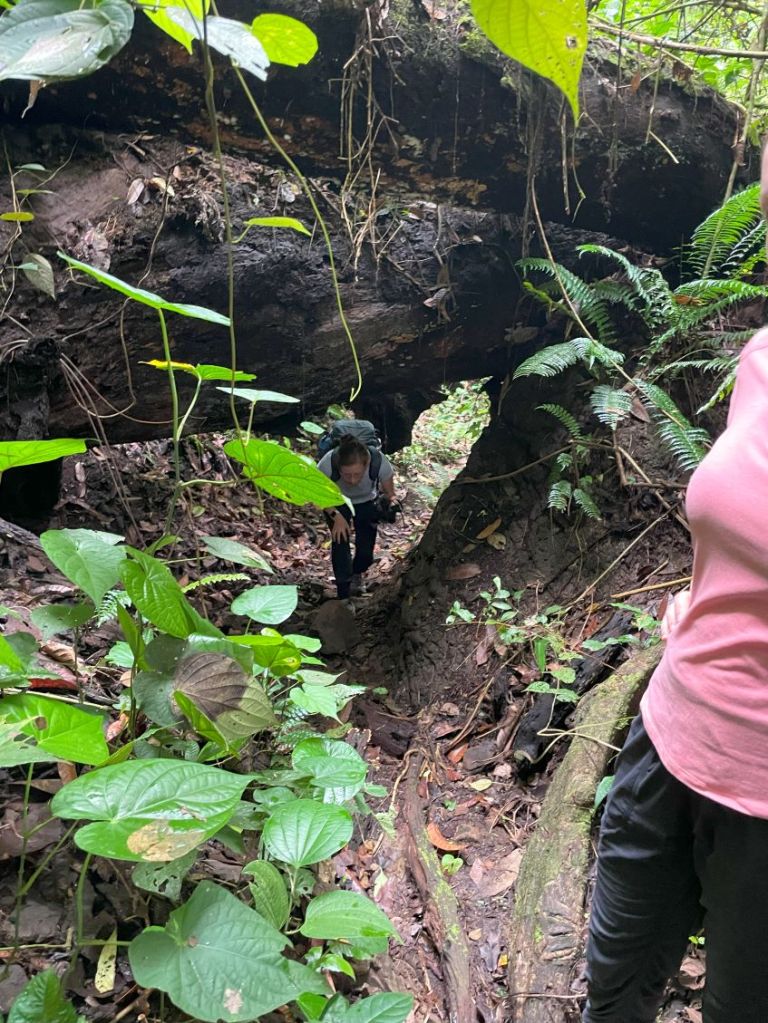
In some places, we walked on solid stone pocked by about a dozen foot-sized holes. Rainald told us that the local lore was that these indentations had been made to help the mules get more stable footing, rather than slipping on the stone.
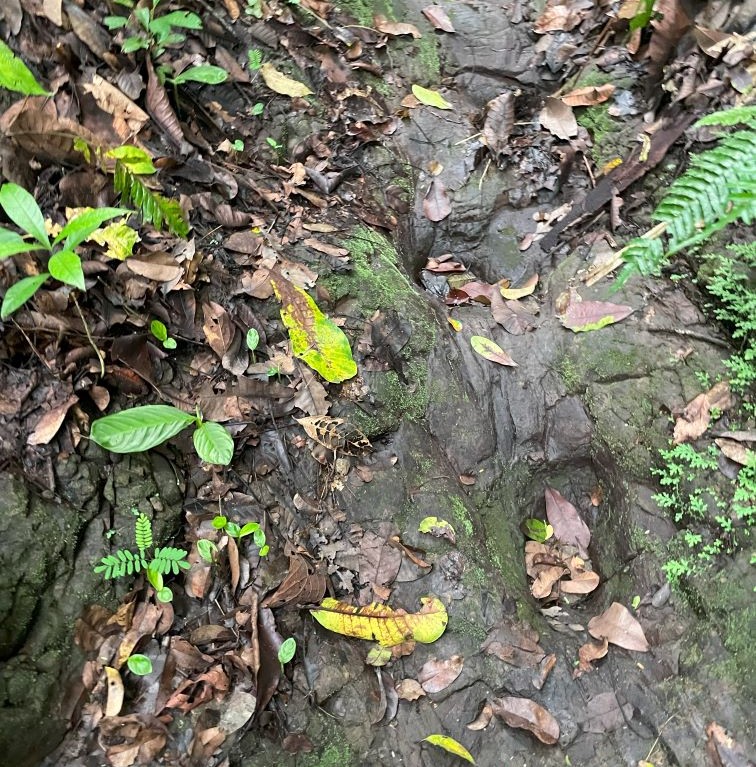
We also saw giant strangler fig trees. These figs have a clever, brutal strategy for competing with other trees for sunlight. Birds eat the figs and then deposit seeds high atop other trees. The strangler fig then starts to grow, spending the first part of its life as an epiphyte, while sending roots towards the ground. Eventually these roots reach the ground, and the fig starts to expand around the host tree. This mature strangler fig has completely obscured its victim, but high above our heads we could still see the gaps in between the roots that the fig sent down towards the soil.
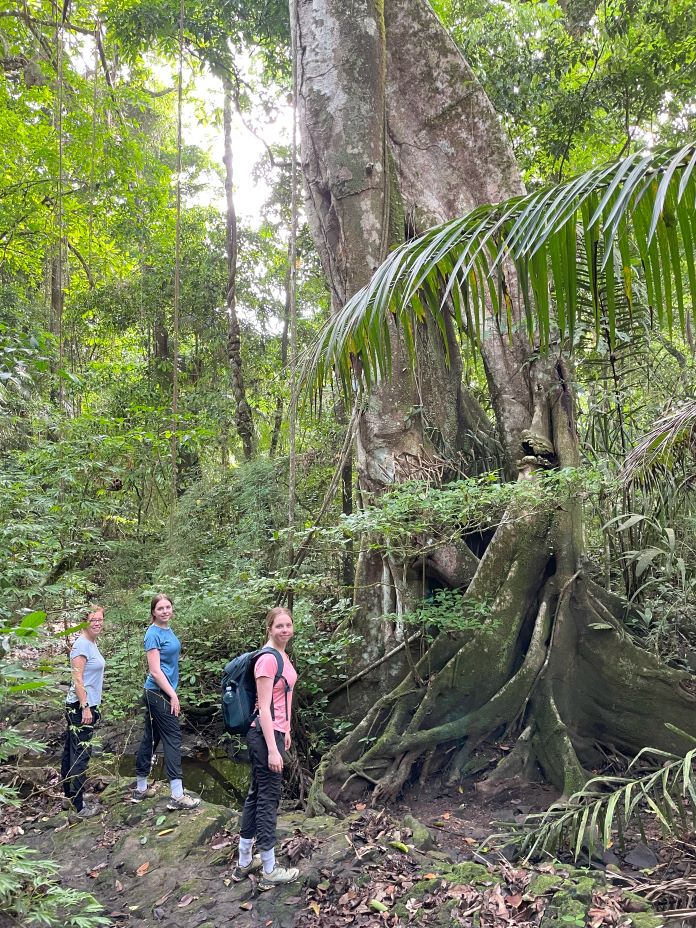
The smaller plants were beautiful in their own right as well, with tropical flowers peaking out among the foliage here and there.
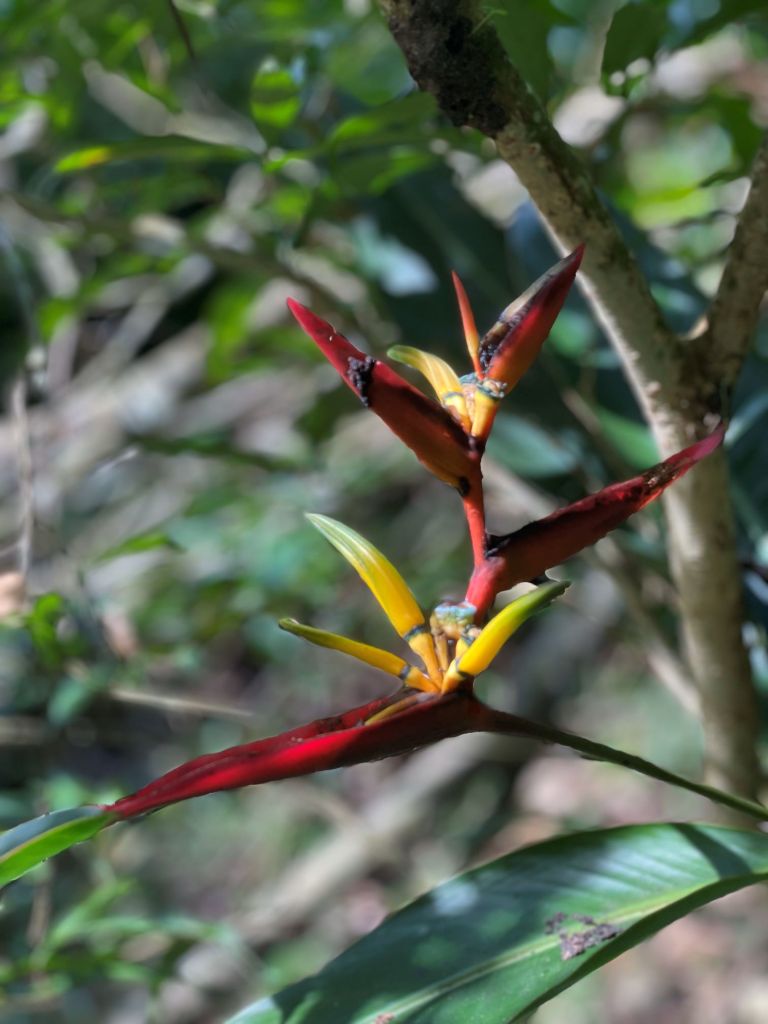
Midway through the hike, we crossed a large creek, and Rainald turned to hike down the creek to take us to a special spot about 15 minutes away.
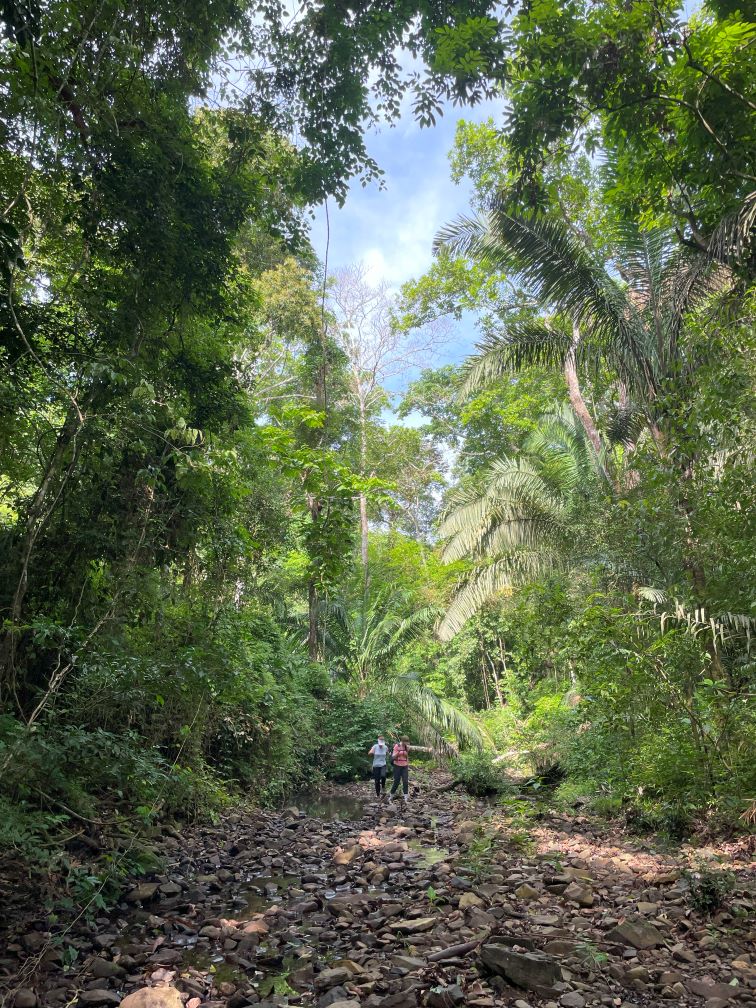
The footing was tough on the loose stones, but the views along the creek were beautiful. Reviews of the views of the creek itself were mixed, as we saw a huge spider along the way.

The spider goes by a variety of names, including the long-legged water spider and fishing spider. Fortunately, for humans these spiders are not particularly dangers. Nevertheless, Lydie has a phobia for spiders and was not a fan. Ahead in the distance, the jungle opened up more as we approached a cliff, and we could hear the sound of a small waterfall. It was a special spot.
This was one of the great benefits of having a guide like Rainald. We never would have known about this place without him. It was also a great place to have a little water looking out at the tree canopy. We had been hiking in the tropical heat for a little more than 2 hours and sweating plenty.
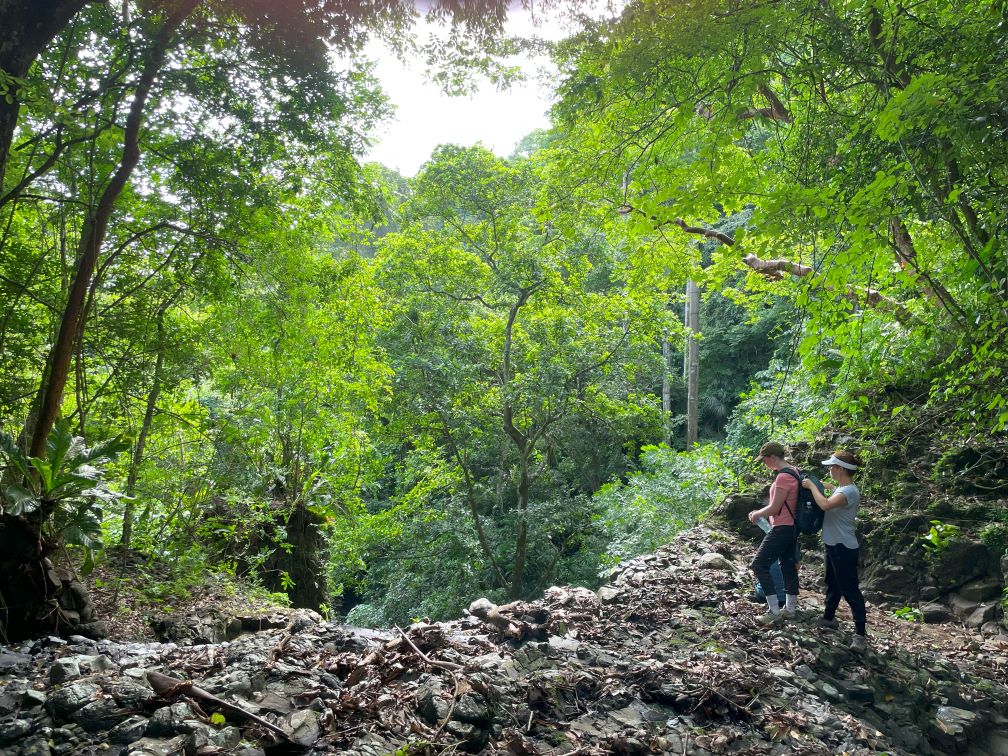
A little refreshed, we hiked back up the creek. Back on track, the trail continued to intensify. In places, the water has worn the path down into deep trenches.
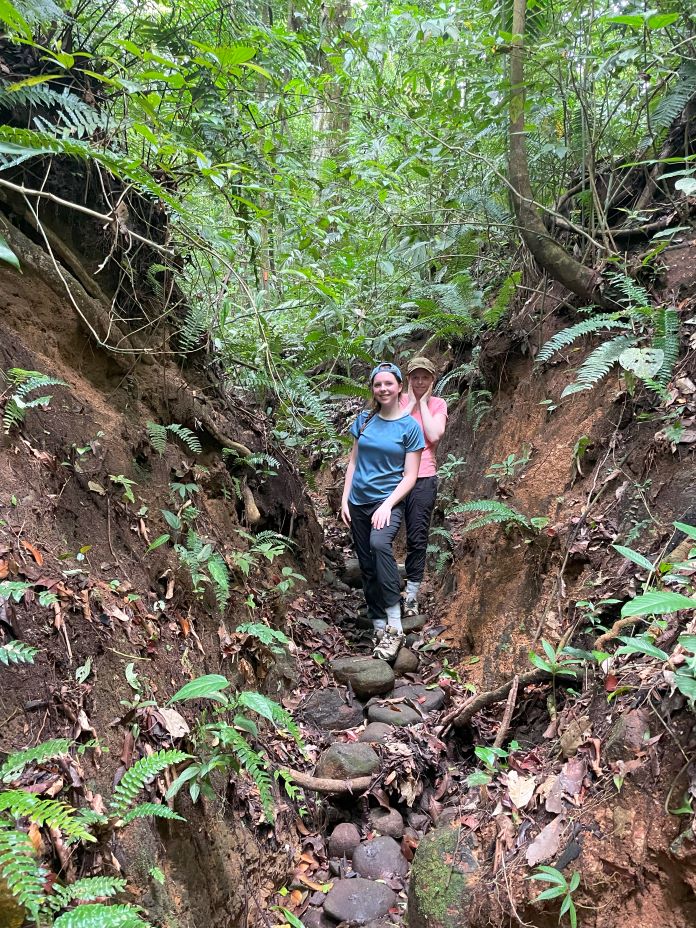
In one of those tighter spots, we came around a corner and surprised a pair of nine banded armadillos.
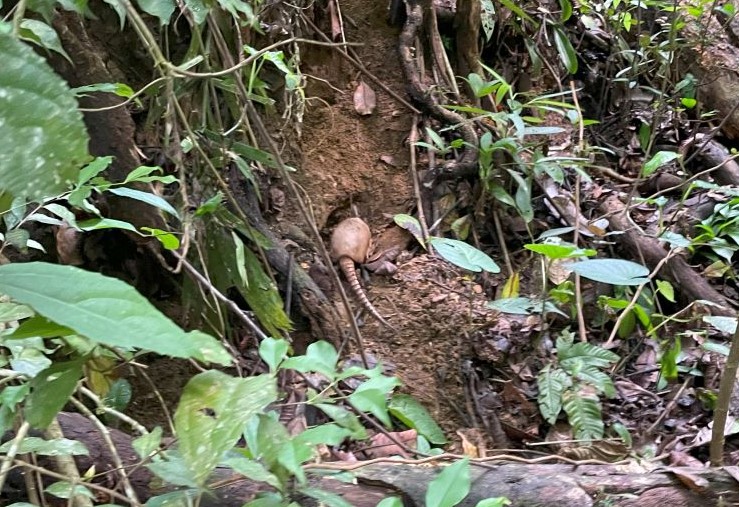
In one spot, a Golden Orb Spider had spun a huge web across the trail.

Fortunately, these spiders also are not dangerous to humans, though Lydie’s patience for the spiders was growing thin. It was a little after 9:30, and the sun was shining brightly, sending shafts of light down to the jungle floor. As the day heated, the birds and monkeys had grown quiet. Rainald was in front, hiking on a relatively flat open section of the path. I was behind him, and this was my view of the trail.

And here’s the close up:
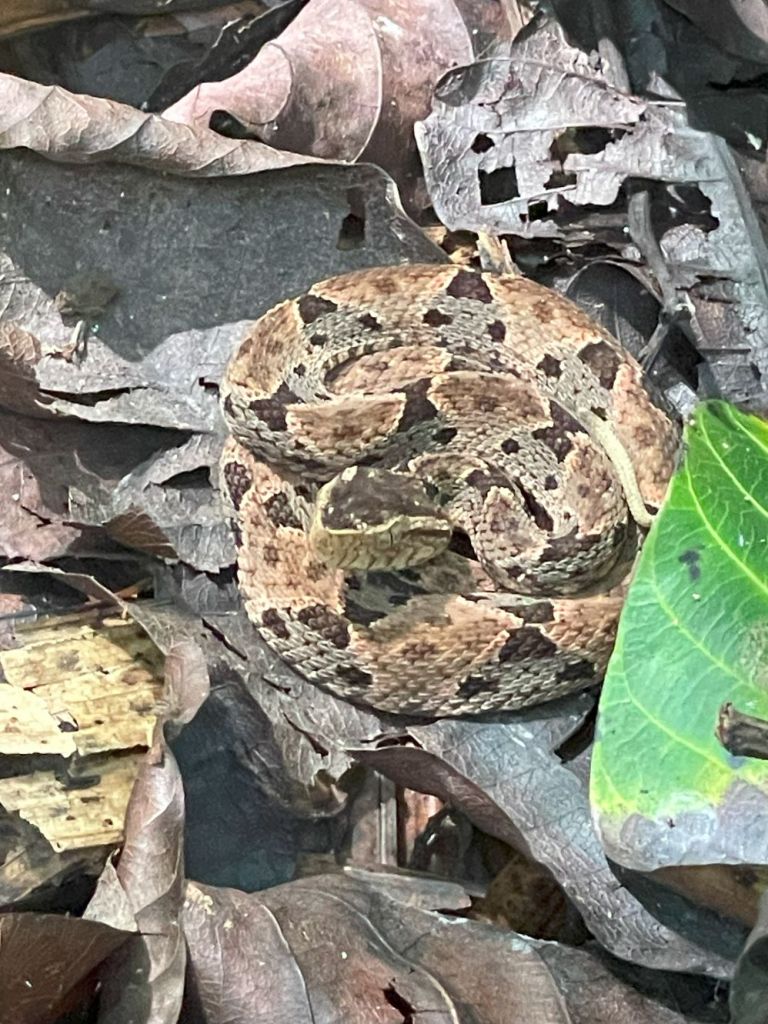
This was a bothrops asper, also known as a fer-de-lance. In Panamá, the snake is often called “equis,” which is Spanish for the letter “X,” due to the black X-shaped marks on the snake’s back. Rainald said that the locals also call this a 24-hour snake because, if one bites you and you don’t get antivenom, you’ll die in 24 hours. Many consider it the most deadly snake in the Americas. And Rainald had walked right over it. If he’d stepped differently, or if we hadn’t seen it, things could have gotten ugly. But since nobody was bitten, this was super cool. We detoured slightly around the snake and continued on our way.
Deep in the jungle we continued to see truly enormous trees. For example, we saw lots of huge bongo trees (cavanillesia platanifolia). These trees have soft wood that retains lots of water. Hitting on the sides of them can produce a deep drum-like sound.
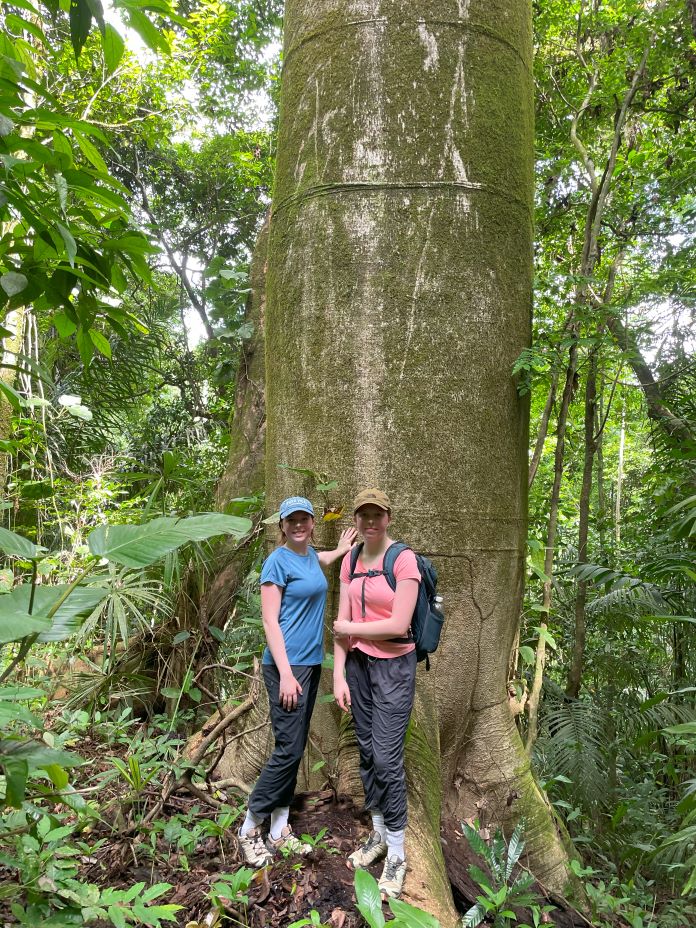
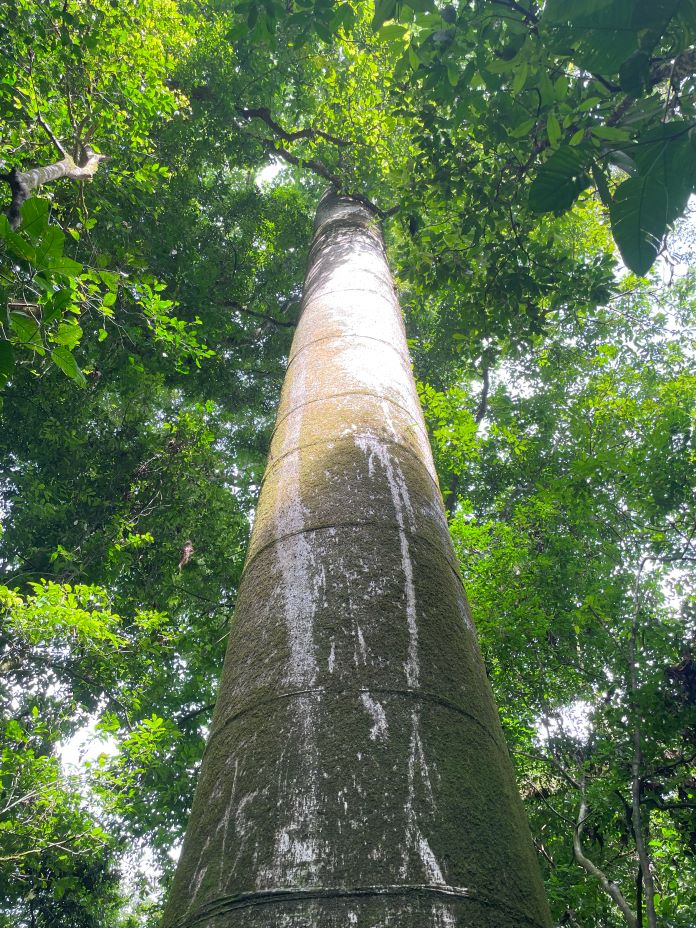
We continued to hike down narrow trails, sometimes in gullies formed by runoff from the rains, and other times on higher ground on the sides of the old road.
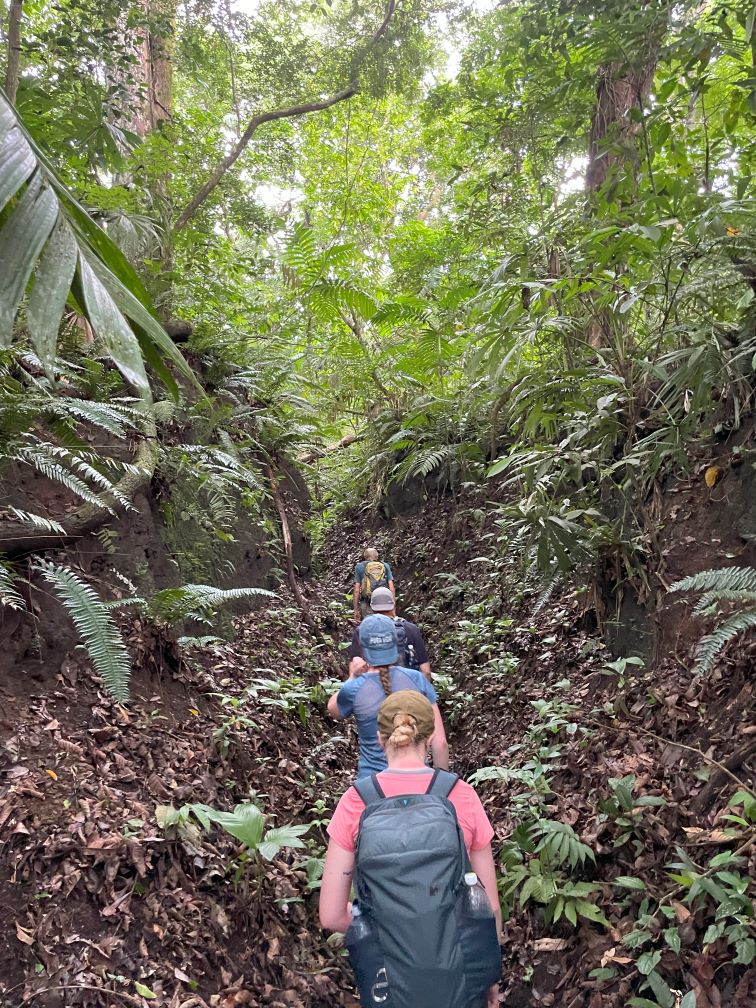
We’d been hiking for more than four hours, and the troops were getting tired. The heat was really starting to get to us. Then, we heard the sound of thunder. At first, we were concerned that this would hamper our hike, but we soon realized that this storm was the best thing that could have happened to us. The temperature dropped, cooling us all. Also, with the thick canopy overhead, only a small amount of rain reached us on the forest floor. What water did reach us was wonderfully refreshing, and we were already soaked with sweat anyway. And the sound was magical.
The rain changed the entire feel of the forest — and washed away some of the spiders that had been tormenting Lydie. Since we had come to experience the rainforest, the shower felt somehow appropriate, giving us a sense of the life cycle of the forest.

At times, the sun would peak through, only to be followed with another shower, with thunder rumbling in the distance.
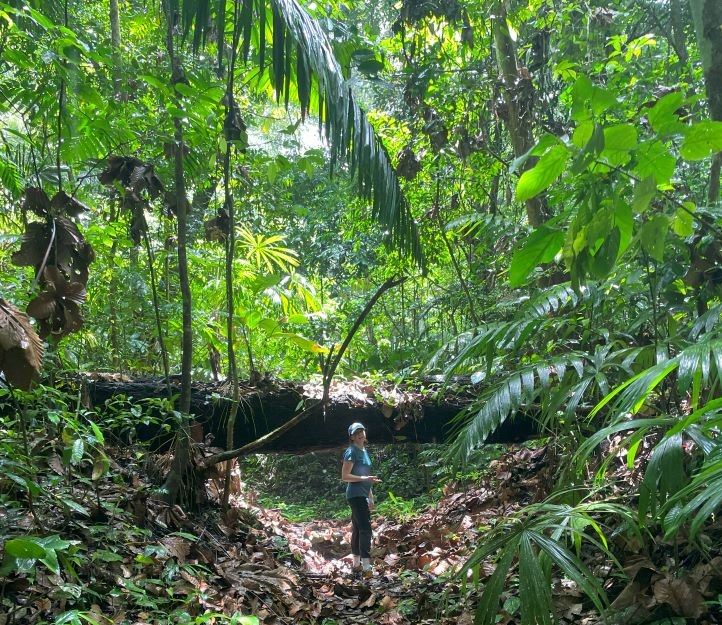
Along the way we passed by a smaller tree with some bizarre fruit.

The fruit comes from the aptly named candle tree (Parmentiera cereifera). The fruit is apparently edible, but we weren’t about to try it. The trail then reached a section where long ago the Spanish cut through the rock rather than going over a steep incline.

Deep in the jungle, the gargantuan trees towered over us. The pictures simply cannot convey the scale of these plants, particularly the buttressed ceiba trees.

Roots the size of my waist ran for dozens of feet in all directions, anchoring these titans to the ground. Any tree or branch that falls quickly decomposes in the rainforest, supporting some fungi every bit as pretty as tropical flowers.
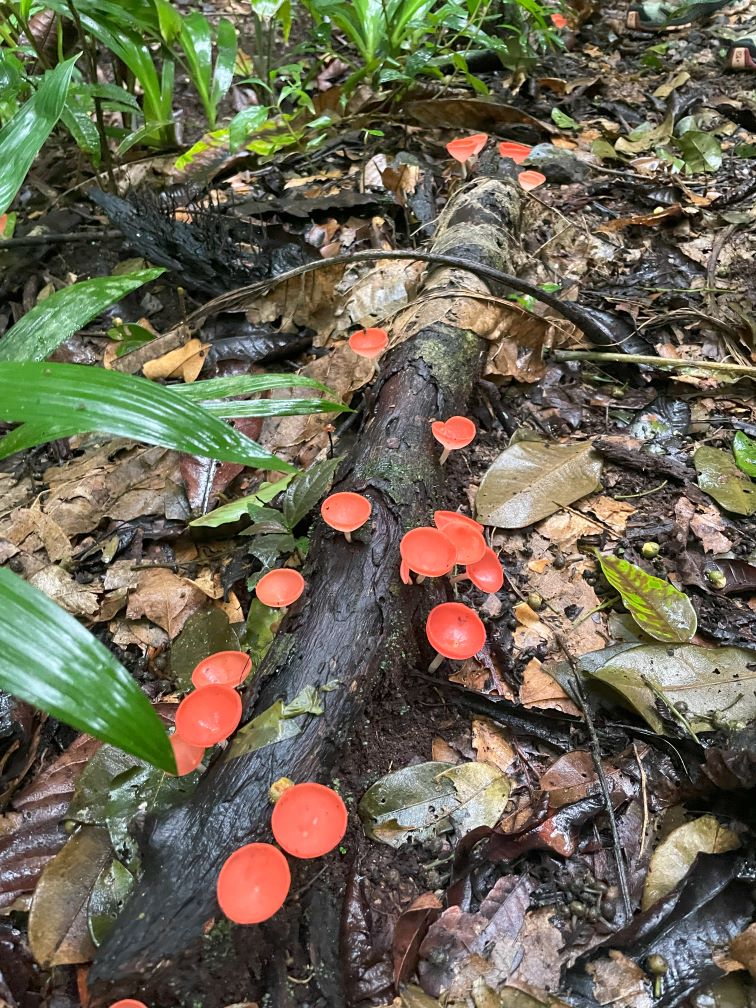
While most of the bromeliads were high in the trees, some found a home closer to the ground.
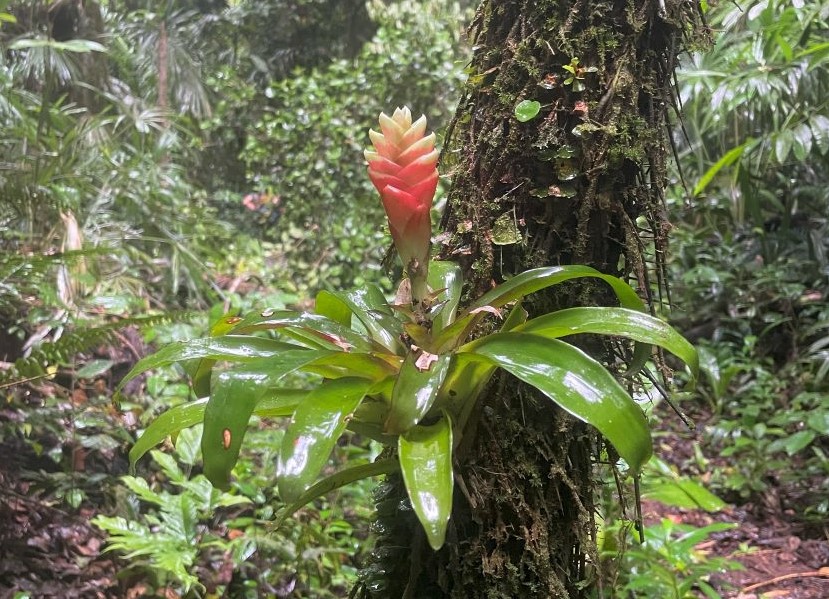
We also encountered some large stands of terrestrial bromeliads, that is, those that root in the ground. Some of the leaves on these monsters were 8-10 feet long and covered in wicked spines.

As we had seen at el Fuerte de San Lorenzo, the leaf cutter ants were hard at work in the rainforest. Here in the jungle, the ants don’t just cut leaves. They clear roads to transport cuttings faster. Rainald told us that there’s an entire cast of ants tasked with roadbuilding – civil engineers in miniature.
There was an amusing parallel between the ants, building roads to transport leaves, and the Spanish, who built el camino de cruces to transfer goods through the same terrain.
We continued down the camino de cruces, passing under massive ceiba trees.
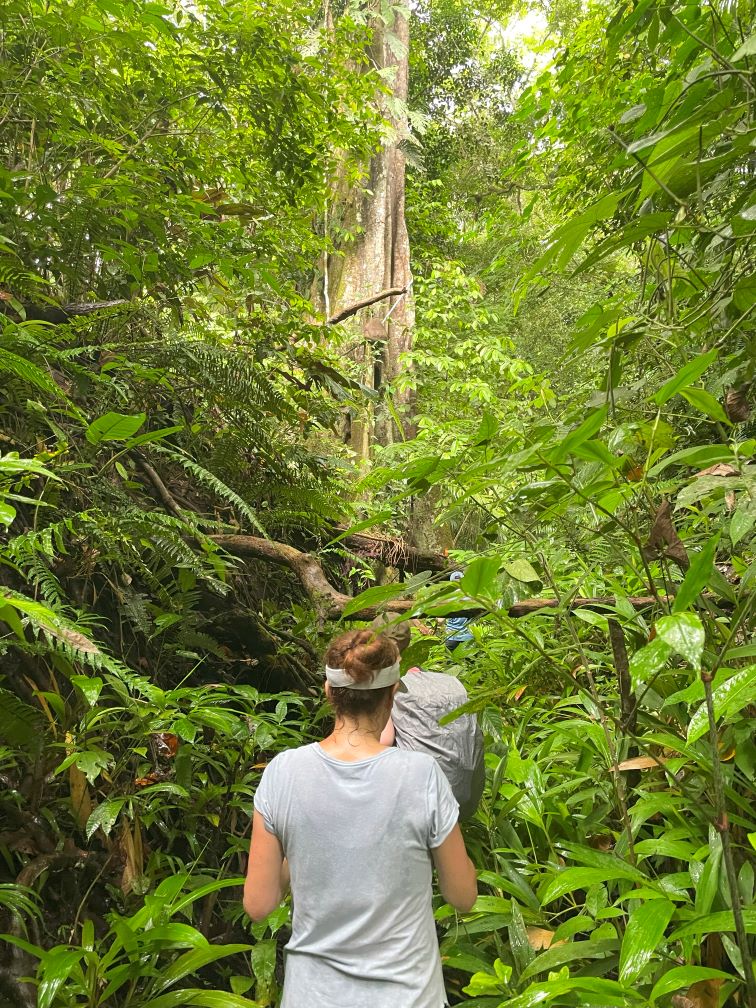

We hit another stretch of solid stone with indentations for (or maybe from) the mules the Spanish used to transport people and valuables. This time, the holes were filled with water, making the footing tricky.

We soon reached another incredible ceiba tree.
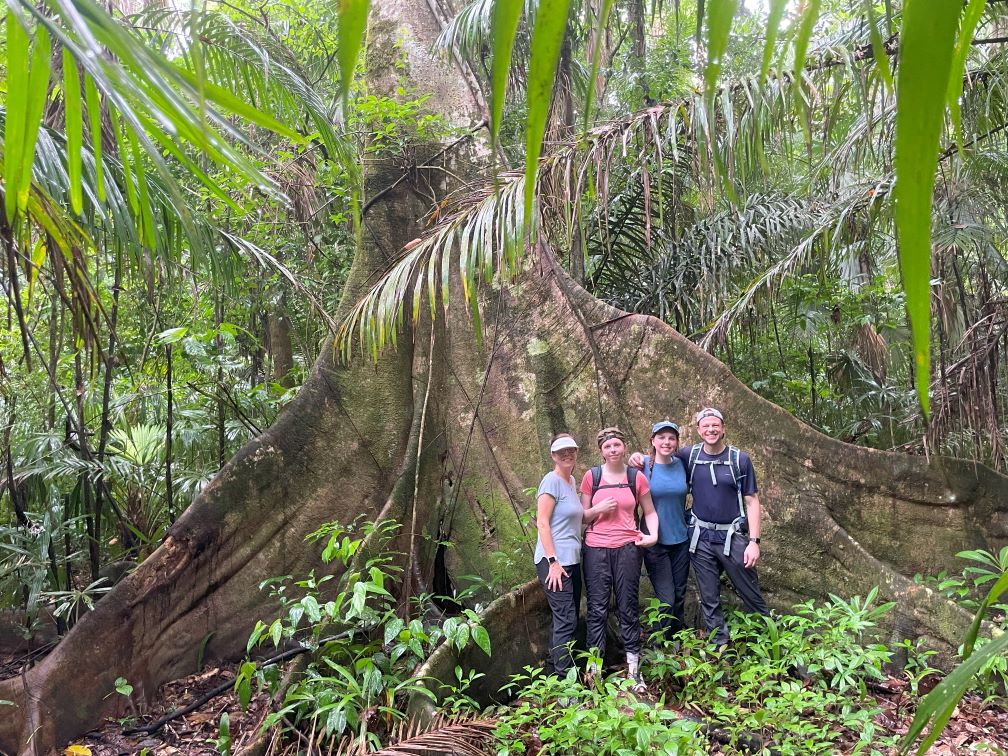
Photos just can’t convey the scale of these trees, and we felt lucky to be able to experience this firsthand despite the heat (and spiders for Lydie). Soon, the landscape started to change slightly as we started to get closer to the Chagres River. In the moist environment, we started seeing an occasional leaf litter toad. These little guys are hard to spot when they aren’t moving.
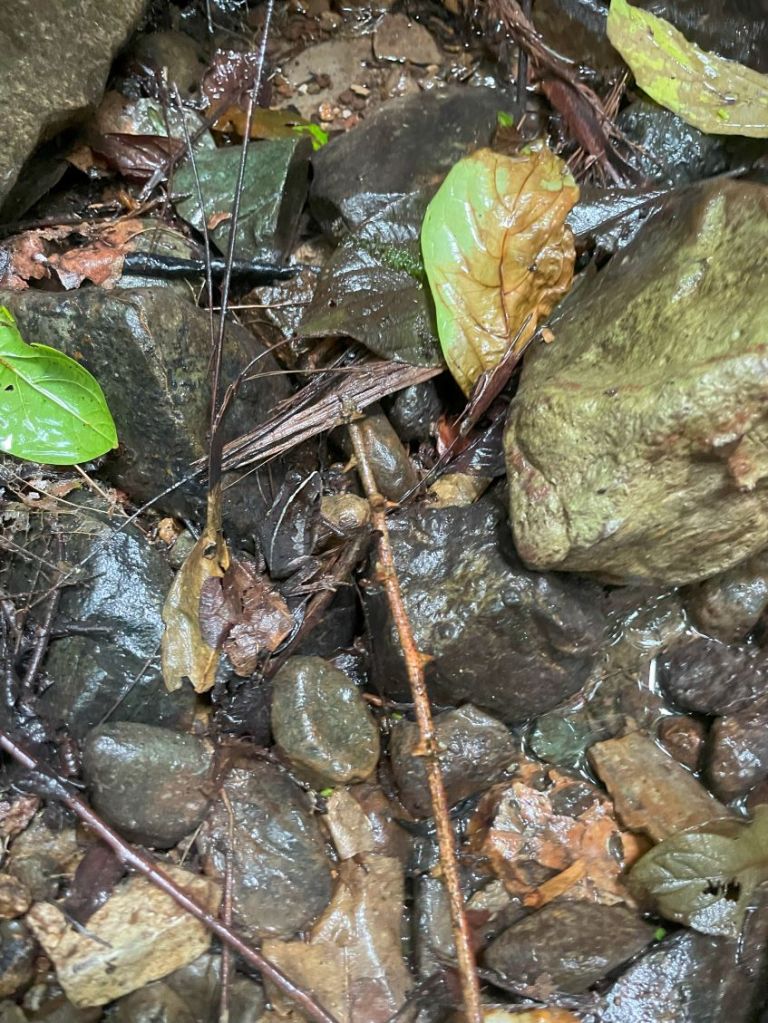
(He’s in the middle of the photo, a little bit to the left.) Nearing the water, we started seeing more palms, some of which had blown down in a storm, making it hard to find the path.

Seven hours into our hike, we reached the ruined remains of Venta de Cruces. There’s not much left of the Spanish settlement, but the steps and foundations of a church still peak through the vegetation.

Rainald led us to a path down to the river, where we could see the boat!
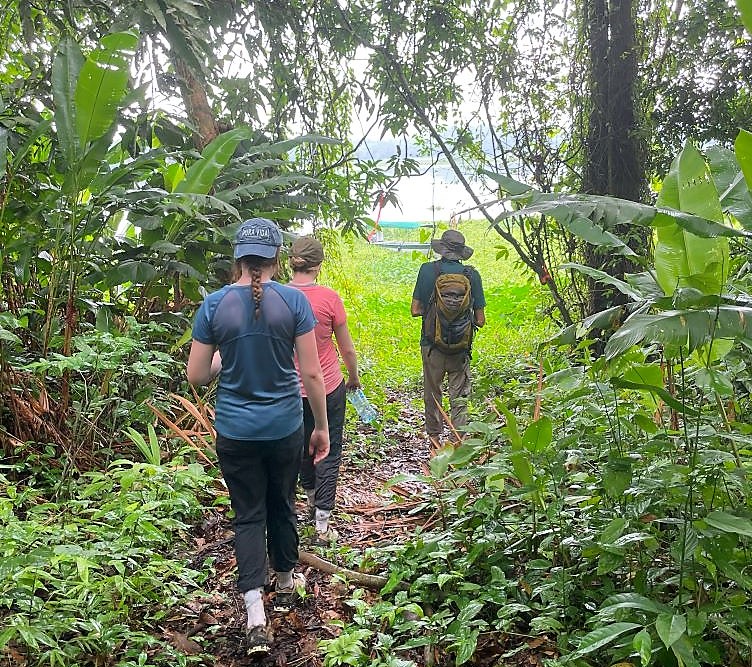
But the boat couldn’t get close enough to land for us to board. And there are crocodiles in the lake, so we weren’t about to wade. Instead, we had to bushwack our way to another spot.
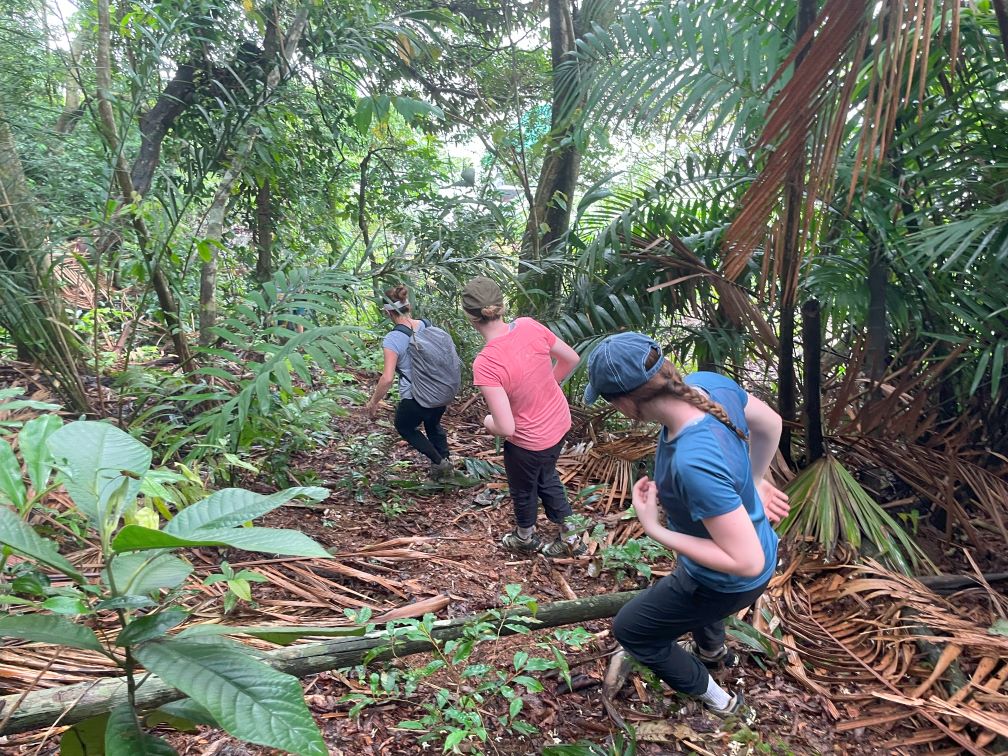
Hiking without a trail truly made us appreciate the Camino de Cruces. It was a tough hike, but just like the leaf cutter ants we saw, it was much easier to travel down a cleared path, even if that path was convoluted. After about 20 minutes, we climbed aboard the boat and headed across the water to the Gamboa Rainforest Reserve. We looked back at the rainforest with fondness and tired satisfaction. We hadn’t transported gold, but we had made some special memories of an unforgettable place.

On the other side of the water, we met the van that took us back to Panamá City. Although we had only gone about 6.5 miles, the hike had taken us 7.5 hours. We were all exhausted and soaked in a lovely combination of rain and sweat. We had drunk all of our water (2 liters each), and Rainald gave us more water in the van. Nevertheless, we all had slight headaches from dehydration. Team Hubbard would never have made it as conquistadores.
Back in Casco Antiguo, we showered and cleaned up. We wandered the streets looking for a place to eat.
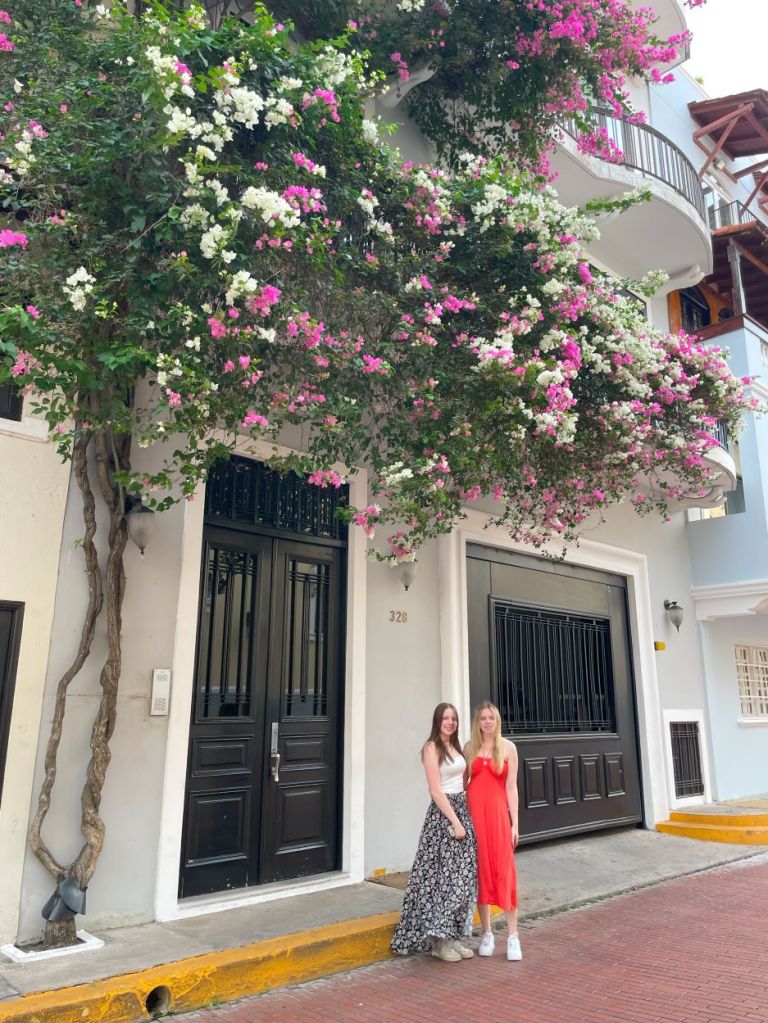
However, before we could have dinner, we had one more task to complete. We walked to the tip of Casco Antiguo where a balcony overlooked the ocean. There, we launched Crabtain Morgan into the sea.

Godspeed, little Caribbean hermit crab. May you make more friends on this side of Panamá than your namesake did. We then found a lovely square with a great restaurant serving local food.
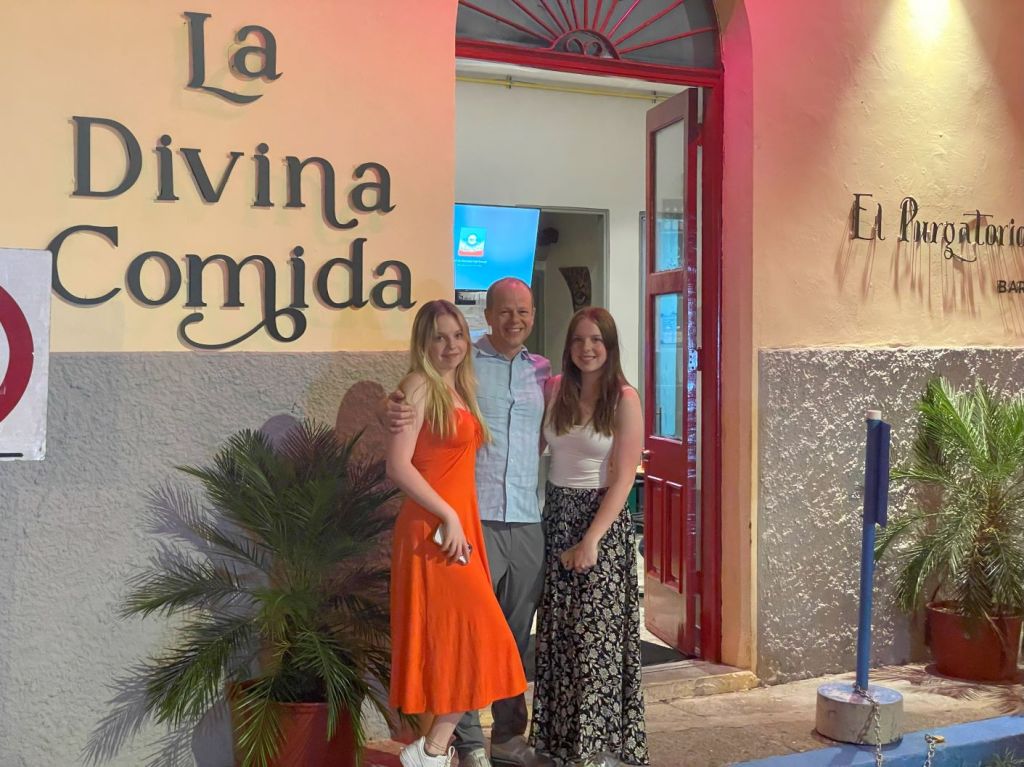
Plus, it had a clever name. “La Divina Comida” means “the divine food” but is a play on words with “La Divina Comeda,” which is “the divine comedy,” a reference to Dante’s narrative poem about descending into hell. The bar was called “El Purgatorio.” After dinner, we got gelato.

After the day’s hard work, we figured we’d earned it. For my part, the day hadn’t been hell, and it hadn’t been purgatory. I thought it was heavenly.
-Will
I am impressed with the gutsiness of your wife and daughters!
LikeLike